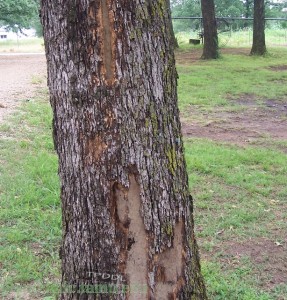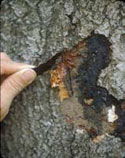 COMMON NAME: Hypoxylon canker on oak
COMMON NAME: Hypoxylon canker on oak
SCIENTIFIC NAME: Biscogniauxia atropunctatum (atropunctata atropunctata)
DISEASE DESCRIPTION
Hypoxylon canker is a common disease of many trees in Texas, such as oak, pecan, elm, sycamore, and yaupon. Although the calendar depicts Hypoxylon canker on sycamore, the photos above are the same disease on oaks. Even though the host trees are different, the descriptions of the disease and the biology of the pathogen are similar.
SYMPTOMS
Trees with Hypoxylon canker on oaks will show symptoms of yellow and/or brown leaves, smaller than normal leaves, reduced stem growth, thinning canopy, dead limbs and branches. Epicormic shoots, or “water sprouts”, often grow on the trunk and larger limbs. The sapwood in the cankered area will become white and stringy, leading to a decay of the structural integrity of the wood.

SIGNS
Hypoxylon canker occurs primarily on stressed trees. The fungus infects the tree through injured limbs and trunk. First evidence of the disease is from dying branches. This dieback continues from branch to branch until the whole tree dies. The fungus infects the inner bark causing the outer bark to fall off and exposing large masses of brown, dusty spores which spread to other trees. Eventually, the brown stage of the fungus becomes black, making the tree look as if the affected area was charred by fire.
BIOLOGY
This fungus does not affect healthy and vigorous trees. However, Hypoxylon can quickly grow in weakened or stressed trees. This disease shows up on trees growing in many different habitats, such as forests, pastures, parks, and urban development areas. Hypoxylon canker can affect any type of oak, including; black, blackjack, laurel, live, post, southern red, Texas red, water and white oaks. There are many sources of stress capable of increasing the weaknesses of trees to pathogens. Many factors in urban environments stress trees. Construction jobs and sites can damage essential roots that provide necessary water and minerals for a healthy tree. Soil compaction and addition of fill soil cause drainage issues and prevent roots from obtaining needed water and nutrients. These events lead to stress, decline and tree death. Extreme climatic conditions such as heat, drought, ice storms, hail damage, lightning, and flooding are capable of causing infection of Hypoxylon. Insect attacks and other diseases, such as oak wilt and root rots, create stress that can predispose the tree to attack by the pathogen. .
MANAGEMENT METHODS
Preventing stress and injuries from occurring and allowing the tree’s natural resistance mechanisms to deter the pathogen is the main way of controlling Hypoxylon. If a tree succumbs to stress or is injured, then actions must be taken to reverse the condition before the pathogen can invade.
Vertical mulching in addition to fertilizing and root zone aeration, are both options in some scenarios. Vertical mulching can also reduce damage due to excessive water, provide necessary aeration during wet periods, allow water penetration during drought periods, and promote the formation of fine feeder roots. Vertical mulching is a process by which a porous matter, such as pea gravel, sand or a mixture of compost with pea gravel, rice hulls or sand is added to holes drilled throughout the root zone of the tree. The holes should be 18 – 24” deep and a few inches in diameter.
RESOURCE LINKS:
https://plantdiseasehandbook.tamu.edu/landscaping/trees/oak/
https://plantclinic.tamu.edu/factsheets/hypoxylon-fact-sheet-3/
This factsheet is authored by James Griffin (PhD Agronomy)
Factsheet information for the plant health issues represented by the images on the 2019 TPDDL calendar were written by graduate students enrolled in the Department of Plant Pathology & Microbiology PLPA601 Introductory Plant Pathology course in the 2018 Fall semester (course instructor: Dr. David Appel). This exercise provides an opportunity for a high impact learning activity where the students are tasked with producing an informational output directed to the general public and to provide opportunity for the students to write.